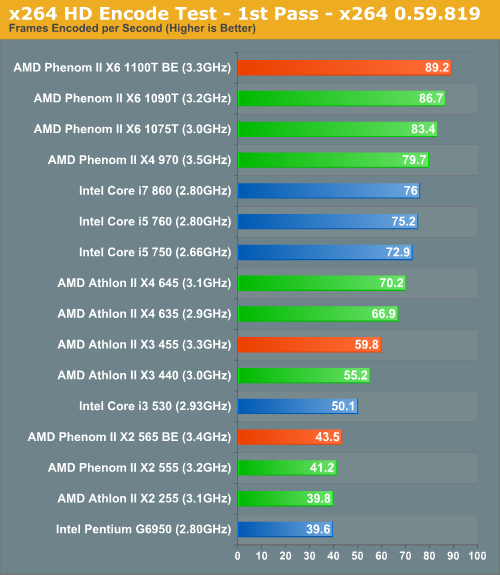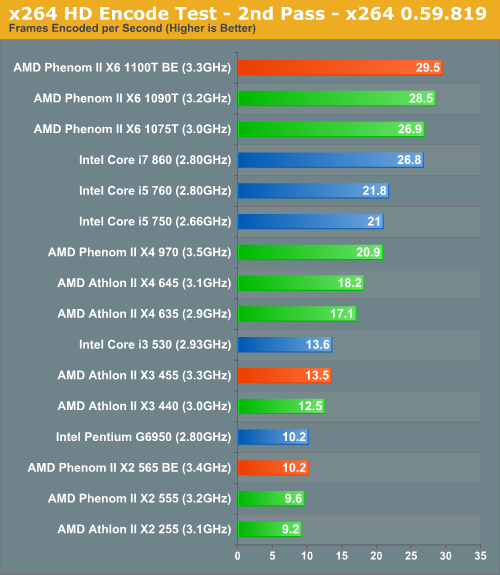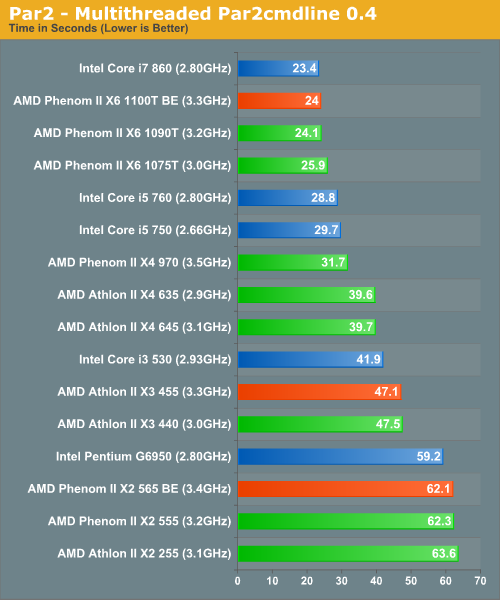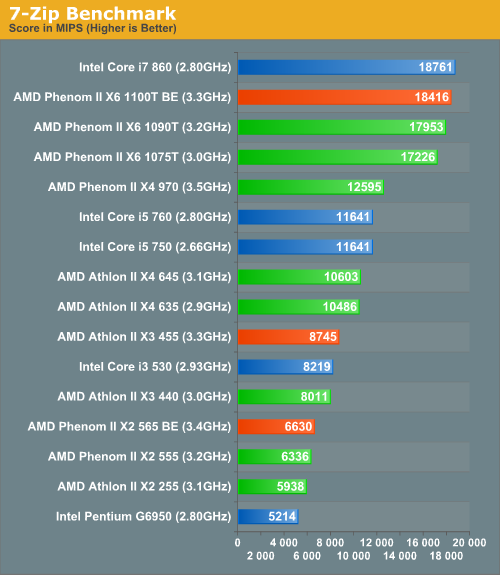AMD's Winter Update: Athlon II X3 455, Phenom II X2 565 and Phenom II X6 1100T
by Anand Lal Shimpi on December 7, 2010 12:01 AM EST- Posted in
- CPUs
- AMD
- Phenom II X6
- Athlon II
- Phenom II
x264 HD Video Encoding Performance
Graysky's x264 HD test uses x264 to encode a 4Mbps 720p MPEG-2 source. The focus here is on quality rather than speed, thus the benchmark uses a 2-pass encode and reports the average frame rate in each pass.

Video encoding and other thread heavy tasks are best suited for AMD's more-is-better core strategy. You get six cores on the 1100T and three with the 455, in both cases the competing Intel part doesn't stand a chance. In the second encoding pass the Athlon II X3 is over 30% faster than the Pentium G6950. Without unlocking additional cores, the Phenom II X2 565 BE doesn't impress here.

PAR2 Multithreaded Archive Recovery Performance
Par2 is an application used for reconstructing downloaded archives. It can generate parity data from a given archive and later use it to recover the archive
Chuchusoft took the source code of par2cmdline 0.4 and parallelized it using Intel’s Threading Building Blocks 2.1. The result is a version of par2cmdline that can spawn multiple threads to repair par2 archives. For this test we took a 708MB archive, corrupted nearly 60MB of it, and used the multithreaded par2cmdline to recover it. The scores reported are the repair and recover time in seconds.

The Phenom II X6 is competitive in our Par2 test, the Athlon II X3 455 is significantly faster than the Pentium G6950 and the Phenom II X2 565 falls short of its target. Rinse and repeat.
7-Zip Benchmark Performance
Included in 7-zip is a pure algorithm test that completely removes IO from the equation. This test scales with core count and as a result we get a good theoretical picture of how these chips perform. Note that the actual 7-zip compression/decompression process is limited to 2 threads so there's no real world advantage to having more cores.











65 Comments
View All Comments
Aone - Tuesday, December 7, 2010 - link
Unfortunately, the auther didn't explain the big and strange difference between the idle power figures of Athlons and Phenoms.For instance:
Athlon II X3 455 (3.3GHz) - 63.9W,
Athlon II X3 440 (3.0GHz) - 80.3W!
Phenom II X4 970 (3.5GHz) - 66.9,
Athlon II X4 645 (3.1GHz) - 75W!
Athlon II X4 635 (2.9GHz) - 79.5W!
shooty - Tuesday, December 7, 2010 - link
I am also interested in this difference... specifically the x2 555 vs the x2 565.Almost a 20W difference in idle and a 40W difference at load!
What is going on to give this huge difference for (just) a clock bump?
Anand, can you please post tested voltages of these cpus? I know from my experience that some motherboards put them at a higher stated voltage (above 1.4v).
BTW, I'm 2 for 2 in getting the two extra cores to be stable on the 555.
Marlin1975 - Tuesday, December 7, 2010 - link
not only that but the lowwer Ghz chip was beating the higher Ghz chip in games.Maybe there is more than just a speed bump?
Anand Lal Shimpi - Tuesday, December 7, 2010 - link
As I mentioned in the test page our older Athlon II/Phenom II numbers were run on a 7-series board vs. the new 890GX board we switched to in the last review. I've pulled the conflicting numbers to avoid confusion :)Take care,
Anand
semo - Tuesday, December 7, 2010 - link
I'm pretty sure the X2 chip offers directed I/O and possibly better vm performance than the X3. It would be interesting to find out.Also I don't like it when the front page introduction differs from the main article's. I think you should keep it consistent across all front page articles (news or reviews).
StevoLincolnite - Tuesday, December 7, 2010 - link
I have a Phenom 2 x6 1090T.Now I'm wondering why you didn't push more voltage through that chip? It can handle 1.45volts with a decent cooler easily enough which would have pushed you over that 4ghz mark.
I'm also surprised at the large performance difference the 100mhz increase in clockspeed provided in the benchmarks between the 1090T and the 1100T!
108fps for the 1090T and 120fps for the 1100T.
That's what... 10-12% improvement for just 100mhz? Doesn't seem to add-up in my eyes.
Finally - Tuesday, December 7, 2010 - link
Just because your chip can handle 1.45V, doesn't mean that any chip can.nitrousoxide - Tuesday, December 7, 2010 - link
Thubans can reach 4.0GHz at 1.4V, that's true for almost all the Thuban parts.MrSpadge - Tuesday, December 7, 2010 - link
The board has changed. Such things matter in games.MrS
chester457 - Tuesday, December 7, 2010 - link
I use 7zip everyday and find your 7zip benchmark a little misleading. I'd prefer if you just did a bench with only 2 cores enabled. PAR2 already tests 3+ core archiving. By using 7zip you're invoking real-world performance because 7zip is a program many people use daily. It'd be nice to have the 2 core (real-world) performance instead of a theoretical one no user can ever hit.